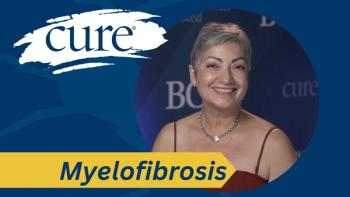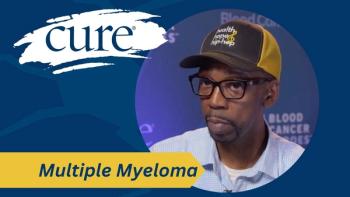
Anti-Androgen Therapies May Find New Home in Breast Cancer
Anti-androgen therapies may eventually be used to treat some patients with breast cancer, according to Tiffany A. Traina, M.D.
With encouraging current data for for androgen receptor (AR) antagonists, future results may make it so that the agents have a spot in the treatment paradigm for many patients with breast cancer, Tiffany A. Traina, M.D., said at the 2016 Lynn Sage Breast Cancer Symposium.
Triple-negative breast cancer (TNBC), which is a heterogeneous disease, houses a group of patients who may benefit from AR antagonists. “There is a subset — that is larger than we initially thought — that upwards of almost 50 percent women with triple-negative breast cancer may have this androgen-driven subtype,” Traina, from the Memorial Sloan Kettering Cancer Center (MSK), said in an interview with CURE. “We now have three phase 2 studies that show signal of activity for targeting androgen in that subset.”
Bicalutamide
The first agent described by Traina was bicalutamide, which was first approved in 1995 to treat prostate cancer. This agent was evaluated in the phase 2 TBCRC011 trial for patients with AR-positive, ER/PR-negative metastatic breast cancer.
Twenty-six patients on the TBCRC011 trial were AR-positive and received bicalutamide at 150 mg daily. The primary endpoint on the trial was clinical benefit rate. Though there were no CRs or PRs on the trial, 19 percent of patients (five patients) had SD for at least six months. An additional 8 percent of patients (two patients) had SD of less than six months.
In a whole transcriptome analysis of the results presented at the 2014 San Antonio Breast Cancer Symposium, Traina and her colleagues came to several conclusions: (1) RNA expression variation was consistent with basal-like breast cancer, (2) AR-positive tumors were noted beyond the luminal AR subtype and (3) there was clinical benefit seen beyond the luminal AR subtype.
Overall, Traina said in her presentation, TBCRC011 was proof-of-concept that bicalutamide had activity in AR-positive metastatic TNBC. An ongoing study at MSK is looking at the agent in combination with the CDK4/6 inhibitor palbociclib for women with AR-positive metastatic breast cancer (
Zytiga
The second-generation AR inhibitor Zytiga (abiraterone acetate) was evaluated in a phase 2 trial of postmenopausal women with ER-positive metastatic breast cancer. A total of 297 patients were randomized to receive Zytiga and prednisone (89 patients) ; Zytiga, prednisone and exemestane (106 patients); or exemestane alone (102 patients). The primary endpoint of the trial was progression-free survival (PFS).
Trial data showed that while overall response rate (ORR) was higher among those receiving Zytiga, prednisone and exemestane (12.1 percent) compared with exemestane alone (6.3 percent), the benefit was not statistically significant. Similarly, the clinical benefit rate was higher with Zytiga, prednisone and exemestane (22.7 percent) compared with exemestane (12.7 percent), but again the data were not statistically significant.
The median PFS with exemestane alone was 3.7 months, compared with 4.5 months with Zytiga, prednisone and exemestane and 3.7 months with Zytiga plus prednisone.
Xtandi
Most recently, Xtandi (enzalutamide) was evaluated in the phase 2 MDV3100-11 trial presented at the 2015 American Society of Clinical Oncology (ASCO) Annual Meeting. In this study, single agent Xtandi was evaluated in patients with advanced AR-positive TNBC. The primary endpoint of the trial — the largest prospective trial of an AR inhibitor in TNBC — was clinical benefit rate at 16 weeks.
Among the 75 evaluable patients at a median age of 50 years, the CBR was 35 percent (26 patients) at 16 weeks and was 29 percent (22 patients) at 24 weeks. Further, six patients had a CR or PR (response rate, 8 percent) and median PFS was 14.7 weeks in the evaluable population.
In the intent-to-treat population (118 patients; those who received more than one dose of Xtandi), the median age of patients was 57 years. The 16-month CBR was 25 percent and the 24-month CBR was 20 percent. The response rate was 6 percent. Median PFS was 12.6 weeks. Median overall survival was 12 months.
Using the PREDICT AR biomarker test, the median PFS was 16.1 weeks in the positive group versus 8.1 weeks in the negative arm. In those who received zero or one prior therapies, the median PFS was 40.4 weeks in patients with PREDICT AR-positive tumors versus 8.9 weeks in those with negative tumors.
Overall, 61 percent of patients (72 patients) experienced a treatment-related adverse event (AE) with one AE being serious. The most common related AEs were fatigue (30 percent), nausea (22 percent), and decreased appetite (11 percent).
Xtandi, Traina said, is the most promising agent in this space and is currently being explored in a “definitive” phase 3 trial (named ENDEAR), which will evaluate the agent in combination with paclitaxel or as monotherapy versus placebo with paclitaxel in patients with locally advanced or metastatic TNBC.
Outside of that, there are other trials in metastatic TNBC evaluating Xtandi with or without a PI3K inhibitor (
Traina emphasized that an AR antagonist could make a huge difference to patients’ quality of life. “Using a hormonal strategy versus what chemotherapy is so much easier for our patients,” she said. “The side effect profile for taking a hormone pill a day where you don't lose your hair, you're not sick to your stomach, you're not vulnerable to infection — it's really great quality of life.”




